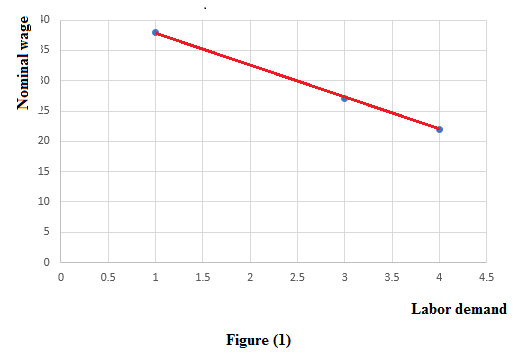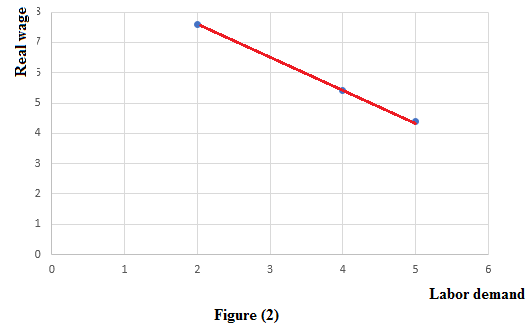
(a)
MPN for each level of employment.
(a)
Explanation of Solution
The marginal product of labor (MPN) is an additional output produced by an additional unit of labor.
It can be calculated using the following formula:
The table (1) below shows the MPN for each level of employment.
TABLE-1:
| Number of workers (N) | Number of widgets produced (Y) | Marginal product of labor (MPN) |
| 0 | 0 | |
| 1 | 8 | 8 |
| 2 | 15 | 7 |
| 3 | 21 | 6 |
| 4 | 26 | 5 |
| 5 | 30 | 4 |
| 6 | 33 | 3 |
(b)
The number of workers hired by the firm at given various levels of nominal wage.
(b)
Explanation of Solution
The equilibrium level of employment for a firm occurs when the nominal wage equals the marginal revenue product of labor. The marginal revenue product of labor is equal to the marginal product of labor times the
It is given that the price of the widget produced by the firm is equal to $5/unit.
Mathematically, the equilibrium condition of the level of employment can be expressed as follows:
Here,
MRPL is marginal revenue product of labor
MPN is a marginal product of labor
W is a nominal wage
P is the price of the good
The table (2) below shows the MRPL when the price is equal to $5/unit.
TABLE-2:
| Number of workers (N) | Number of widgets produced (Y) | Marginal product of labor (MPN) | Marginal revenue product of labor (MRPL) |
| 0 | 0 | ||
| 1 | 8 | 8 | 40 |
| 2 | 15 | 7 | 35 |
| 3 | 21 | 6 | 30 |
| 4 | 26 | 5 | 25 |
| 5 | 30 | 4 | 20 |
| 6 | 33 | 3 | 15 |
Now, according to employment equilibrium condition (1), when
- Nominal wage is equal to $38, the firm will hire 1 worker.
- Nominal wage is equal to $27, the firm will hire 3workers.
- Nominal wage is equal to $22, the firm will hire 4 workers.
As a firm hires labor up to the point where nominal wage equals the marginal revenue product of labor.
(c)
Graphical relationship between a firm’s labor demand and nominal wage. And the firm’s labor demand curve.
(c)
Explanation of Solution
Figure (1) below shows the graphical relationship between a firm’s labor demand and nominal wage.

The graph in figure (1) is different from the labor demand curve because the labor demand curve plots the value of real wage equal to marginal product against the demand for labor.
Real wage is equal to the nominal wage divided by the price level. Thus, at nominal wage $38, $27, $22 and price $5, the value of real wage is equal to $7.6, $5.4, and $4.4, respectively.
As in real terms, the firm hires a number of workers up to a point where the real wage is equal to the marginal product of labor. Thus, according to the table (1), at,
- Real wage equal to $7.6, the firm will hire 2 workers
- Real wage equal to $5.4, the firm will hire 4 workers
- Real wage equal to $4.4, the firm will hire 5 workers
The figure (2) below shows the firm’s labor demand curve. It depicts the graphical relationship between the real wage and labor demand.

(d)
Firm’s labor demand and production level at a fixed nominal wage of $38 and price $10/unit.
(d)
Explanation of Solution
The table (3) below shows the MRPL when the price is equal to $10/unit.
TABLE-3:
| Number of workers (N) | Number of widgets produced (Y) | Marginal product of labor (MPN) | Marginal revenue product of labor (MRPL) |
| 0 | 0 | ||
| 1 | 8 | 8 | 80 |
| 2 | 15 | 7 | 70 |
| 3 | 21 | 6 | 60 |
| 4 | 26 | 5 | 50 |
| 5 | 30 | 4 | 40 |
| 6 | 33 | 3 | 30 |
According to the employment equilibrium condition (1), at a fixed nominal wage $38, the firm will hire 5 workers. As beyond this level of workers, the marginal revenue product of labor (MRPL) falls below the nominal wage $38.
Thus, at fixed nominal wage $38 and increased price level from $5 to $10, the firm hires a greater number of workers compared to 1 worker found in part (b) and produces higher level of output equal to 30 units compared to 8 units found in part (b).
(e)
Effect on labor demand and production when there is an introduction of new technology.
(e)
Explanation of Solution
At fixed nominal wage $38 and price $5/unit, the firm was hiring 1 worker and production level was equal to 8 units. Now, it is given that the introduction of new technology doubles the number of units produced by the same number of workers.
When output doubles, then MPN double. This further doubles MRPL, as the MRPL rises to80. This is equal to MRPL in part (d), where the price was doubled from $5/unit to $10/unit.
Thus, the firm will hire the same number of workers equal to 5, as in part (d). It is just the production level that doubles from 30 units to 60 units due to the introduction of new technology.
(f)
Relationship between answers in part (d) and part (e).
(f)
Explanation of Solution
Since the marginal revenue product of labor (MRPL) is equal to the marginal product of labor (MPN) times the price (P) of the good, thus, any change in either P or MPN, will lead to an equivalent change in MRPL. And the equilibrium level of employment for a firm occurs when the nominal wage equals the marginal revenue product of labor.
This implies that the numbers of workers hired will remain the same in both the cases, i.e., when either P doubles as in part (d) or MPN doubles as in part (e).
Want to see more full solutions like this?
Chapter 3 Solutions
MACROECONOMICS-MYLAB ECONOMICS
- Suppose the marginal product of labor in the economy is given by MPN = 200 – 0.5N, while the supply of labor is 100 + 4w Find the market-clearing real wage rate What happens if the government imposes a minimum wage of 40? Is there involuntary unemployment? What happens if the government imposes a minimum wage of 60? Is there involuntary unemployment?arrow_forwardWhat is the equilibrium wage rate? what is the equilibrium level of employment?arrow_forwardSuppose that a country experiences a reduction in productivity – that is, an adverse shock to the production function.A) What happens to the labor demand curve? Show the change on the graph.B) How would this change in productivity affect the unemployment rate if the labor market is always in equilibrium?Explain your answer referring to the graph.arrow_forward
- How will each of the following affect the current level of full employment output?Explaina) A large number of immigrants enter the country.b) Energy supplies become depleted.c) New teaching techniques improve the educational performance of high schoolseniorsd) A new law mandates the shutdown of some unsafe forms of capital.arrow_forwardSuppose a firm’s hourly marginal product of labour is given by MPN = 0.2(200 − N), where N is the number of labour hours used in production. The amount of labour supplied by workers, NS, is given by NS = 100 + 5w, where w is the real wage. (a) Suppose the current real wage is equal to 20. How much labour will the firm want to hire? How much labour will the workers want to supply? Is there excess supply or excess demand of labour in the economy? Do you expect the real wage to go up or go down in this case? (b) Find the equation of the labour demand and calculate the equilibrium levels of real wage and full-employment. (c) If the government decides to tax the labour income, the equation of labour supply becomes NS = 100 + 5(1 − τ )w. Suppose τ = 40%. Repeat part (b). Compared to the results in (b), do the equilibrium levels of real wage and full-employment increase or decrease? Provide an intuitive explanation to your answers.arrow_forwardProduction function for firm is Ys=ln(Ld)Utility function is U(Yd, Ld)= Ys+ln(1-Ls)1) Write down maximization problem of firm and find labor demand curve2) Write down maximization problem of household and find labor supply curve3) Write down market clearing conditions4) Calculate equilibrium employment and real wage5) If the price is equal to $2, what would be the nominal wage in equilibriumarrow_forward
- In 1954, Canadian Prime Minister Louis Stephen St. Laurent was paid a salary of $15 000. Stephen Harper, the Prime Minister in 2012, was paid $157 731. The price index for 1954 is 14.1 and the price index for 2012 is 121.7. What is, approximately, Prime Minister St. Laurent's salary equivalent in 2012 dollars? Help me.arrow_forwardWhich of the following people would be unemployed (or belonging to any labor market group) according to official statistics? Shortly explain why or why not. f(e) A worker who quits his job because he thinks the pay is insufficient. (f) A teenager who gets discouraged looking for work and stops lookingarrow_forwardShow each of the following in your graph. Assume that the economy of your graph's country has an actual unemployment rate that is less than the natural unemployment rate.arrow_forward
- John's employer tells him that he will be getting an decrease in his hourly wage of 10%. John also learns that his cost of living is falling by 15%. In economic terminology, John is getting a: Question 35 options: A) A nominal wage increase and a real wage decrease B) A nominal wage decrease and a real wage decrease C) A nominal wage increase and a real wage increase D) A nominal wage decrease and a real wage increasearrow_forwardExplain whether each of the following events increases,decreases, or has no effect on the unemployment rateand the labor-force participation rate.a. After a long search, Jon finds a job.b. Tyrion, a full-time college student, graduates andis immediately employed.c. After an unsuccessful job search, Arya gives uplooking and retires.d. Daenerys quits her job to become a stay-at-homemom.e. Sansa has a birthday, becomes an adult, but has nointerest in working.f. Jaime has a birthday, becomes an adult, and startslooking for a job.arrow_forwardThe relationship between output and employment is:arrow_forward
 Macroeconomics: Private and Public Choice (MindTa...EconomicsISBN:9781305506756Author:James D. Gwartney, Richard L. Stroup, Russell S. Sobel, David A. MacphersonPublisher:Cengage Learning
Macroeconomics: Private and Public Choice (MindTa...EconomicsISBN:9781305506756Author:James D. Gwartney, Richard L. Stroup, Russell S. Sobel, David A. MacphersonPublisher:Cengage Learning Economics: Private and Public Choice (MindTap Cou...EconomicsISBN:9781305506725Author:James D. Gwartney, Richard L. Stroup, Russell S. Sobel, David A. MacphersonPublisher:Cengage Learning
Economics: Private and Public Choice (MindTap Cou...EconomicsISBN:9781305506725Author:James D. Gwartney, Richard L. Stroup, Russell S. Sobel, David A. MacphersonPublisher:Cengage Learning Essentials of Economics (MindTap Course List)EconomicsISBN:9781337091992Author:N. Gregory MankiwPublisher:Cengage Learning
Essentials of Economics (MindTap Course List)EconomicsISBN:9781337091992Author:N. Gregory MankiwPublisher:Cengage Learning Brief Principles of Macroeconomics (MindTap Cours...EconomicsISBN:9781337091985Author:N. Gregory MankiwPublisher:Cengage Learning
Brief Principles of Macroeconomics (MindTap Cours...EconomicsISBN:9781337091985Author:N. Gregory MankiwPublisher:Cengage Learning Economics (MindTap Course List)EconomicsISBN:9781337617383Author:Roger A. ArnoldPublisher:Cengage Learning
Economics (MindTap Course List)EconomicsISBN:9781337617383Author:Roger A. ArnoldPublisher:Cengage Learning





